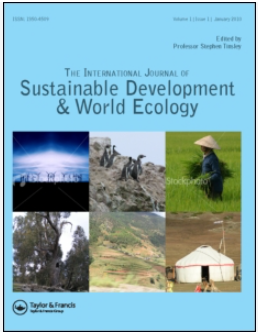作物集约化对土壤质量和有机碳储量的影响——以巴基斯坦喀喇昆仑中部哈拉莫什河谷为例
IF 7.7
3区 环境科学与生态学
Q1 ECOLOGY
International Journal of Sustainable Development and World Ecology
Pub Date : 2022-08-25
DOI:10.1080/13504509.2022.2116613
引用次数: 0
摘要
过度耕作和密集种植等农业操作会消耗土壤有机碳(SOC),因此可持续农业管理对于减少温室气体(GHG)排放至关重要。本研究评估了在巴基斯坦吉尔吉特上哈拉莫什地区,作物集约化对双熟和单熟模式下土壤质量和土壤有机碳储量的影响。土壤样品取自种植区(DC和SC) 3个深度(0 - 20cm、20 - 40cm和40 - 60cm)。采用标准方法对所选土壤质量参数和有机碳进行分析。方差分析结果表明,不同种植模式(直流稻和直流稻)土壤温度、湿度、pH、有机碳和有机碳含量差异极显著(p < 0.001),而容重(BD)、电导率(EC)和粘土含量差异不显著。SC比DC多保留4.4%的水分,而BD则随深度的增加而增加。两个种植区土壤质地均为沙壤土。SC区的平均SOC和SOC比DC区高12%。土壤有机碳储量与土壤有机碳、水分(p < 0.01)、土壤有机碳(EC)呈极显著正相关(p < 0.05),与容重、pH (p < 0.01)、沙度(p < 0.05)呈负相关。DC明显降低了土壤质量和有机碳储量,降低了山地农业土壤的健康水平。本文章由计算机程序翻译,如有差异,请以英文原文为准。
Crop intensification effects on soil quality and organic carbon stocks: a case study of Haramosh Valley in Central Karakorum, Pakistan
ABSTRACT Agricultural operations such as excessive tillage and intense cropping deplete soil organic carbon (SOC), making sustainable agriculture management critical for reducing greenhouse gas (GHG) emissions. This study evaluates the impact of crop intensification on soil quality and soil organic carbon stocks (SOCS) under double cropping (DC) and single cropping pattern (SC) in upper Haramosh of Gilgit, Pakistan. Soil samples were taken from cropping zones (DC and SC) under three depths (0–20, 20–40, and 40–60 cm). Standard methods were used to analyze selected soil quality parameters and SOC. Statistical analysis using ANOVA showed that soil temperature, moisture, pH, SOC, and SOCS highly significantly differed (p < 0.001) for different cropping patterns (DC and SC), whereas bulk density (BD), electrical conductivity (EC), and clay were not significantly different. The SC retained 4.4% more moisture and had lower BD than the DC, while BD increased with increasing depth. The texture of the soil was sandy loam at both cropping zones. The mean SOC and SOCS of SC were greater (by 12%) than in the DC zone. Pearson correlation showed a significant and positive correlation of SOC stock with SOC, moisture (p < 0.01), and EC (p < 0.05), but had a negative correlation with bulk density, pH (p < 0.01), and sand (p < 0.05). DC apparently degraded soil quality and organic carbon reserves, thus reducing the soil health in mountain agriculture.
求助全文
通过发布文献求助,成功后即可免费获取论文全文。
去求助
来源期刊
CiteScore
11.10
自引率
3.60%
发文量
58
审稿时长
18-36 weeks
期刊介绍:
The International Journal of Sustainable Development and World Ecology is now over fifteen years old and has proved to be an exciting forum for understanding and advancing our knowledge and implementation of sustainable development.
Sustainable development is now of primary importance as the key to future use and management of finite world resources. It recognises the need for development opportunities while maintaining a balance between these and the environment. As stated by the UN Bruntland Commission in 1987, sustainable development should "meet the needs of the present generation without compromising the ability of future generations to meet their own needs."

 求助内容:
求助内容: 应助结果提醒方式:
应助结果提醒方式:


